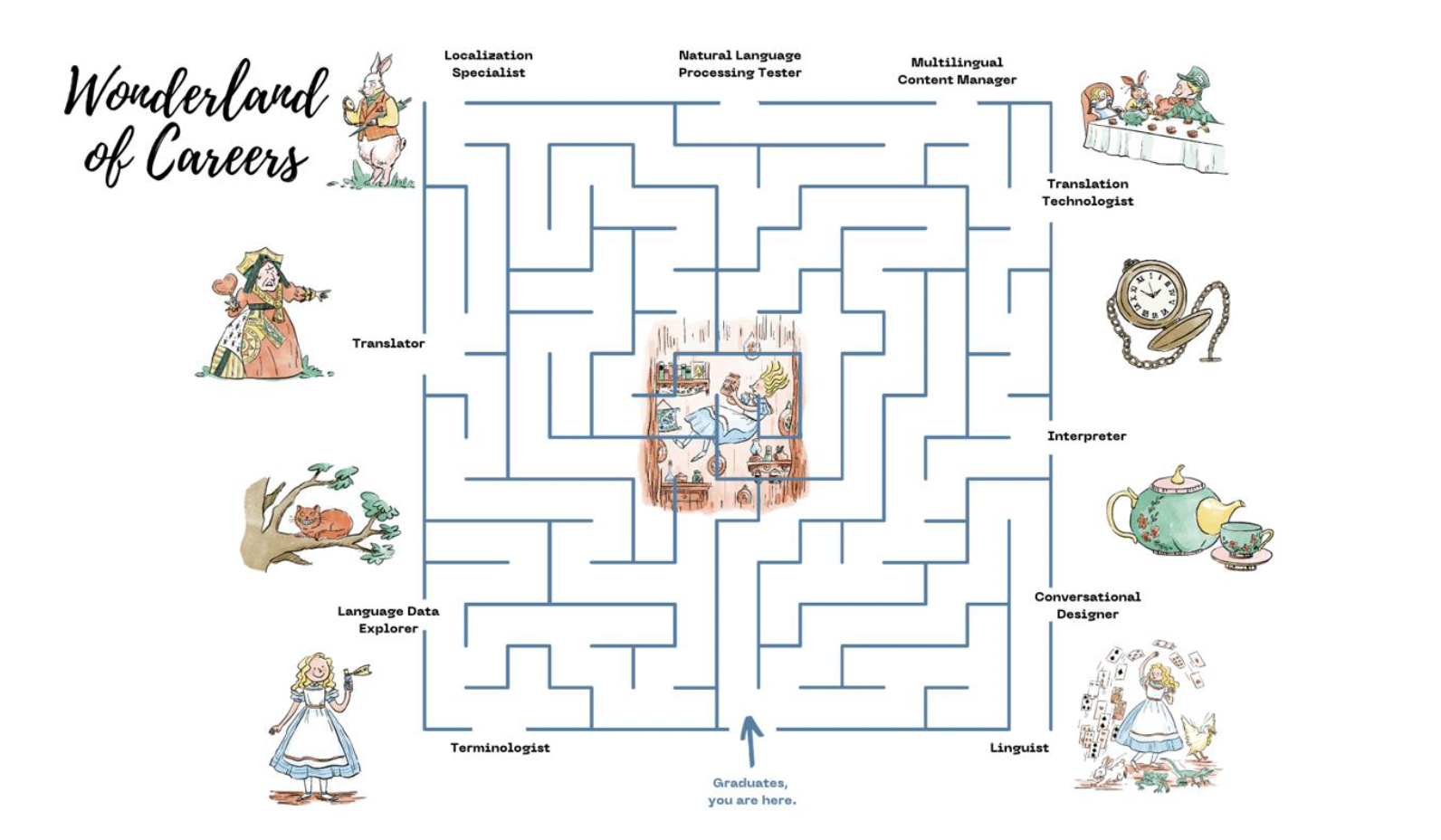- Home
- Resource Center
- Articles & Videos
- Navigating the Babelverse: Teaching in an AI Wonderland
22 March 2024
Navigating the Babelverse: Teaching in an AI Wonderland
This article received the 2024 Rising Star Scholarship. It explores the impact of AI on education and the global language industry.

In the words of Professor Moreno-Sandoval: "People think artificial intelligence is intelligent, but it's not" (Puerto, 2023). These words hit home in the world of the modern translator, which I refer to here as the Babelverse. Like Alice in Wonderland chasing the White Rabbit, in the field of globalization, internationalization, localization and translation (GILT), lecturers around the world are trying to catch up with a hyperactive rabbit (a.k.a. technology) that shows no signs of slowing down. AI has taken us down a whole new rabbit hole of its own, changing our perceptions in every field of knowledge, and the dilemma has taken a seat in our classrooms. Either we choose to embrace it, or we choose to rebel against it.
Rebelling against it can lead to condemnation, just like the Queen of Hearts, who runs to stay in the same place so that nothing will change. Those who take this stance, the technophobes, cry "Off with their heads!" when technology makes an apocalyptic appearance in the translation profession, and their dystopian interpretation of the situation comes to the fore, arguing that AI is occupying the terrain that once belonged to translators (Eszenyi et al., 2023).
Deciding to embrace it, however, means taking a seat at the Mad Hatter's tea party to observe firsthand a changing AI-driven GILT wonderland. At first, this fantasy land may seem chaotic, overwhelming, and unmanageable. Much like Alice, it's important to cultivate adaptability, flexibility, curiosity, and an open mind. As she learns from her interactions with the trickster Cheshire Cat, we must critically incorporate AI technologies to enhance our teaching and learning, and avoid using technology without a clear educational purpose.
After my visit to this AI wonderland, I am committed to guiding students through the blurring boundaries between the work of human translators and the capabilities of machines. Unlike the Queen of Hearts, we are not isolated from the real world, but connected to how technology advances, how translators can embrace it, and are aware of the evolution of current jobs to adapt our teaching approach to today's world. However, we should not leave everything to technology, because our students also need to understand the art of translation and its practical application.
Today’s Higher Education Institutions need to understand their role in this Wonderland, in which “translation is not a solely cognitive human act anymore” (Rodríguez de Céspedes, 2022, p.116), but one in which technology and linguistics hold hands. The “translation technology advisor”, as suggested by Sandrini (quoted by Sánchez-Gijón, 2022), could be integrated into universities to research emerging technology's professional applications and career trends in this field.
The rapid development of AI contrasts with our ability to keep up. This makes it very tempting to throw in the towel and accept the inevitability of a professional future in which technologies will always be far superior to human translators. The reality is that our role will obviously continue to change and transform into that of a mediator, but without losing its true essence. In other words, the human translator acts as a gatekeeper to technology-generated content. In this light, our new role requires us to step out of the shadows and assert our professional authority as translators and the status of translation as a craft.
In addition to the often-mentioned "at-risk" professions of translator, interpreter, terminologist, QA specialist, reviewer, proofreader, post-editor, or linguist, we need to navigate a diverse maze of careers that offer a multitude of opportunities. This includes roles such as language consultants, translation technologists, conversation designers, NLP testers, language technology experts, or even language data explorers, all of whom have the ability to navigate the complexities of machine and human language.
To potentially weather this storm, instructors should not discourage students from the professional path of translation, but rather focus on the value of machine translation literacy (Bowker & Ciro, 2019). In the multilingual Babelverse we live in, we need to educate students and, more importantly, society on how to use these new "smarter" machines. We should not forget that the most recent publicly available tools are not without flaws and often tend to "hallucinate". Therefore, the human eye to evaluate and improve their performance is of paramount importance (Kenny, 2022).
To this end, educators should consider integrating AI tools into the curriculum, for example, in the assessment, evaluation, and editing of machine-generated content. Teaching critical evaluation and emphasizing the importance of accuracy, style, and cultural nuance is also important. Alternative strategies should focus on customizing and adapting AI tools to meet the unique needs of specific projects or industries, including teaching fine-tuning techniques. Students will also need to demonstrate their unique skills and abilities in working with AI, helping them to build a strong portfolio. In short, adaptability, innovation, experimentation, hands-on experience, and practical learning are the strategies of today's GILT instructor.
In conclusion, Lewis Carroll's Alice's Adventures in Wonderland parallels the evolving landscape of language translation, where technology is blurring the lines between human expertise and machine capabilities. Just as Alice navigates a realm that bends reality,
we must embrace coexistence with AI while balancing knowledge of traditional practices with the irreplaceable human touch. As technology advances translation, the next generation will need to be fluent in both human linguistics and technology integration. This means that graduates will face a rapidly evolving professional environment in which they will be required to perform specific tasks that may overlap and don't respond to clear-cut categories (Konttinen et al., 2020) as they did in the past.
To navigate the Babelverse, the core of translation must remain an art-transmitting ideas between cultures requires human perspective, empathy, and context that no software can fully replicate. Teachers should embrace technological advances while recognizing the enduring need for human creativity, emotion, and critical thinking. Like Alice between two worlds, we walk a shifting line between past and future, reality and dreams, humans and machines. The challenge is to skillfully blend both sides.
An Interview with Alexandra

Alexandra Santamaría Urbieta
Senior Lecturer at Universidad Internacional de La Rioja (UNIR, Spain).


